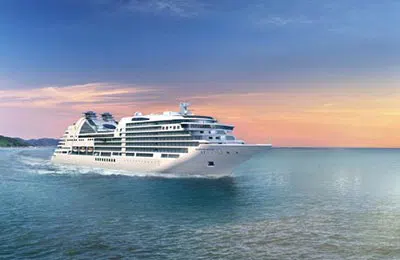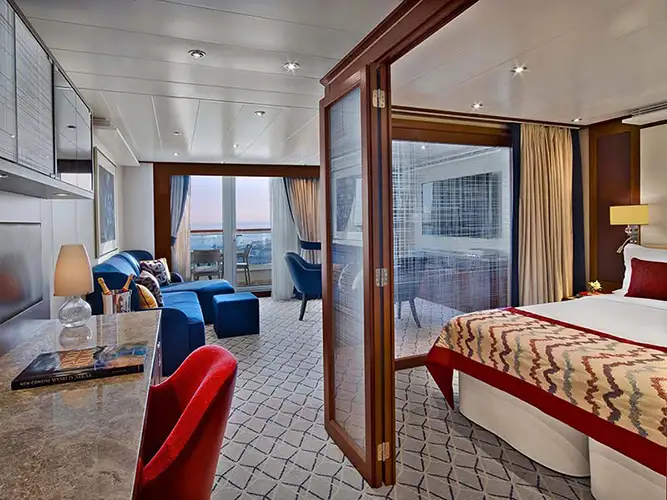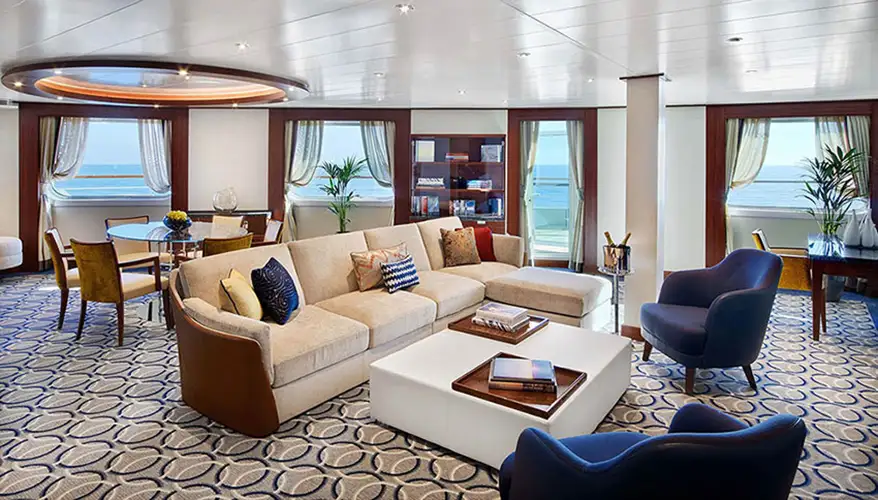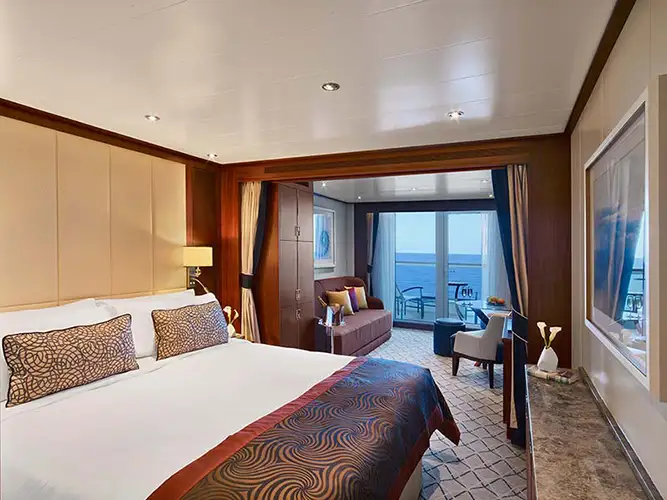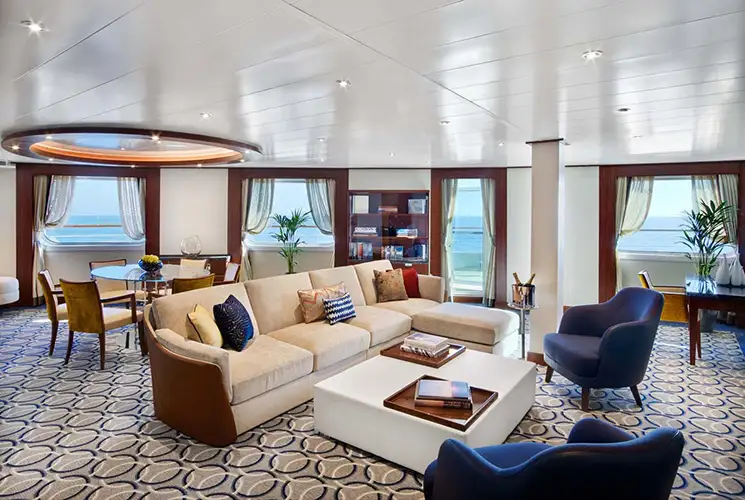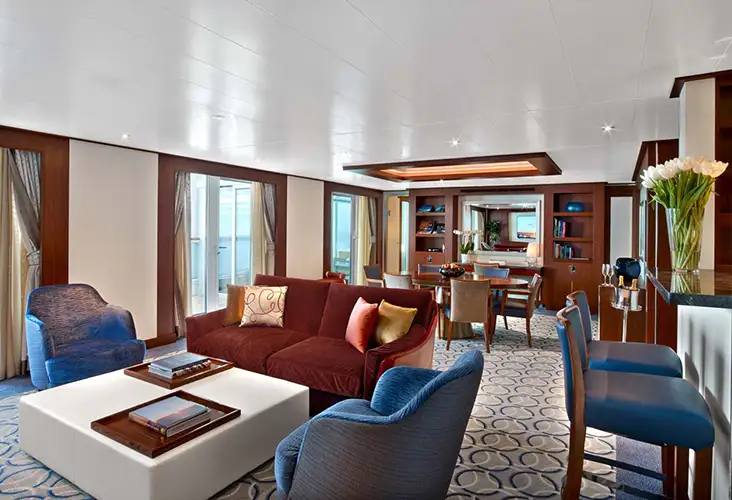Seabourn Mediterranean: 14 nights from Venice with Seabourn Ovation
Oct 9, 2027
Italy, Slovenia, Croatia, Montenegro, Greece, Turkey
Cruise itinerary
Departure Port: Venice ➞
Landing: Istanbul
-
Saturday, October 9, 2027 - 5:00 PMVenice
-
Sunday, October 10, 2027 8:00 AM - 5:00 PMPirano
-
Monday, October 11, 2027 9:00 AM - 6:00 PMSibenik
-
Tuesday, October 12, 2027 8:00 AM - 6:00 PMKotor
-
Wednesday, October 13, 2027Navigation
-
Thursday, October 14, 2027 8:00 AM - 6:00 PMPorto Torres
-
Friday, October 15, 2027 8:00 AM - 6:00 PMNafplion
-
Saturday, October 16, 2027 7:00 AM - 10:00 PMAthens
-
Sunday, October 17, 2027 8:00 AM - 6:00 PMMonemvasia
-
Monday, October 18, 2027 8:00 AM - 6:00 PMAghios Nikolaos
-
Tuesday, October 19, 2027 8:00 AM - 6:00 PMMykonos
-
Wednesday, October 20, 2027 8:00 AM - 6:00 PMCesme
-
Thursday, October 21, 2027 8:00 AM - 11:00 PMKusadasi
-
Friday, October 22, 2027Navigation
-
Saturday, October 23, 2027 7:00 AMIstanbul
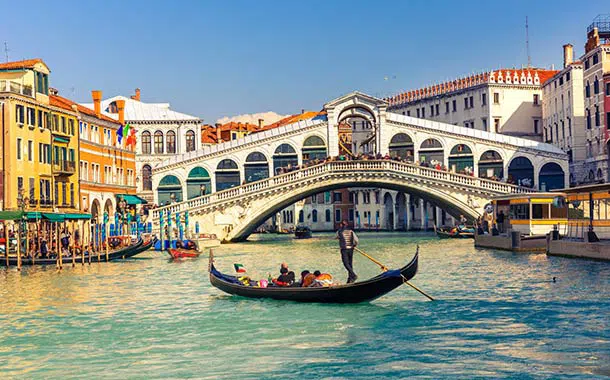
Venice
Setting sail from Venice on a cruise ship is unique and unforgettable. Discover all the cruises that depart from Venice for a great start to your holiday!
Venice it is one of the golden destinations of our age. A unique city of 120 islands, with an ancient history and endless waterways, it attracts a constant flow of tourists from all over the world to see its inspiring architecture and navigate its canals.
There are many souvenirs you can bring home from Venice, but the most lasting memory will be your impression of the city itself.
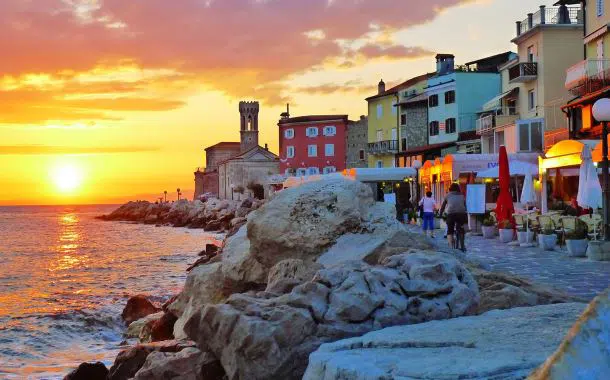
Pirano
Pirano or Piran of Istria (in Slovenian Piran, in Venetian Piràn) is a municipality of 17,882 inhabitants in southwestern Slovenia, on the Adriatic coast. It is a small Slovenian town with specific characteristics, and whose urban heritage is the best preserved in the entire region. The characteristic of this peninsula is known throughout the world. Up close, you can admire the typical architecture that reveals a strong Venetian influence, which is also found in other cities on the Slovenian coast. The city has preserved its medieval village: narrow streets, many squares and churches, all within walking distance from the sea. Tartini Square, located in the center, takes its name from the famous violinist and composer Giuseppe Tartini. His statue is in the central point of the square. Piran is surrounded by a circular wall that allows Piran to be a member of the European Circle of Cities with outer walls. Open-air exhibitions take place throughout the year in different locations involving illustrious men. The church of San Giorgio, patron saint of the city, built on a hill, has a splendid view of Piran and the surrounding area which extends to the Croatian and Italian coasts. The structures (hotels, hostels, guesthouses), cultural visits (churches, art galleries, museums, aquarium) make Piran an unforgettable place.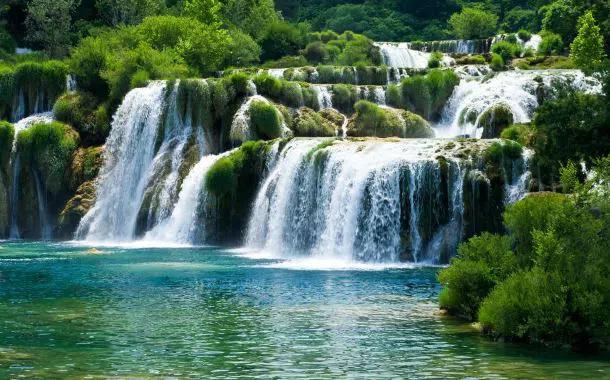
Sibenik
Sibenik is a Croatian city, which is located on the beautiful coast of Dalmatia. Famous for its Saint-Jacques cathedral, which appears on the UNESCO World Heritage List. The peculiarity of Sibenik is its traditional hat in orange and black which also represents the colors of the city. Known for its scenic beauty and the cultural richness of its historical monuments. Do not miss the statue of King Petar Kresimir IV between the park and the start of the walk along the sea. For a short period of history, Sibenik was the seat of the King of Croatia. The metropolis was under Venetian rule for almost 300 years. The old part of the city, rich in churches, palaces and ancient noble houses in typical Dalmatian stone and well-preserved walls, a real jewel. One of the most interesting sites is the garden of the medieval monastery. Sibenik has a Mediterranean climate with summer temperatures around 30 °C. The driest months, therefore the best for traveling, are July and August. A few hundred meters along the coast you will find numerous bars, restaurants and pizzerias. During the summer nights you can walk in the city and enjoy the delicious ice cream, usually homemade. In summer, there are also many popular and classical music concerts.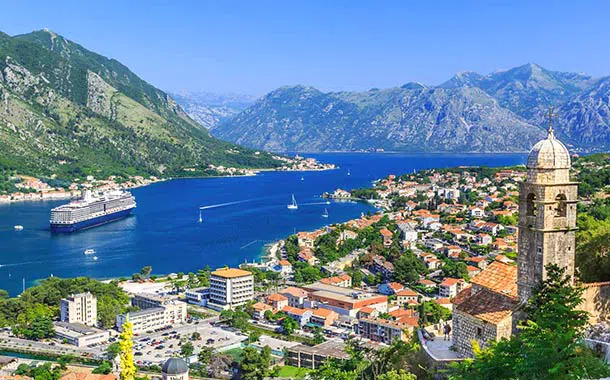
Kotor
The Adriatic Sea penetrates the jagged coast of Montenegro and winds between high mountains until it meets the exquisite and walled medieval city of Kotor.
Along the Adriatic coast of the former Yugoslavia, we find one of the most unique and fascinating European coastal areas, the city hidden in Montenegro, Kotor.
Located at the bottom of a bay, the beautiful medieval city of Kotor is considered a Mediterranean location surrounded by cliffs and an interesting historic wall. The tourist attractions of Kotor are easily reached with a pleasant walk. This small walled city, declared a UNESCO World Heritage Site, has compact dimensions that make it comfortable and easy to visit.
The central part of Kotor was built between the XII and XIV centuries. A historic center surrounded by a rather thick wall, four and a half kilometers long and fifteen meters high. This immense fortified wall reaches the bastion of Sveti Ivan (San Giovanni).
Inside the walls, it preserves an urban network cut into the stone. Its most emblematic work is the Cathedral of San Trifone, built in the 12th century. Inside the church it contains objects and frescoes sculpted during the 14th century. Furthermore, The Orthodox Church of San Nicolas, built between 1902 and 1909 in neo-Byzantine style and that of San Luca (13th century) built in Romanesque and Byzantine style.
Together with the churches, the city includes many palaces that tell its history: the Maritime Museum, located in the Grgurina Palace, a splendid baroque building located in the historic center of the country. The Drago house, with its beautiful Gothic windows, the Prima building, where Renaissance and Baroque lines are combined, the Ducal Palace and the Bizanti, both from the 17th century and the Napoleonic theater in the 19th century.
In Kotor, it is very common to see locals located along the rocky coast in the lower part of the city. In the old part of the area you will find many shops and restaurants that will delight your eyes. This location is the classic ideal city to spend quiet days or for a romantic getaway.
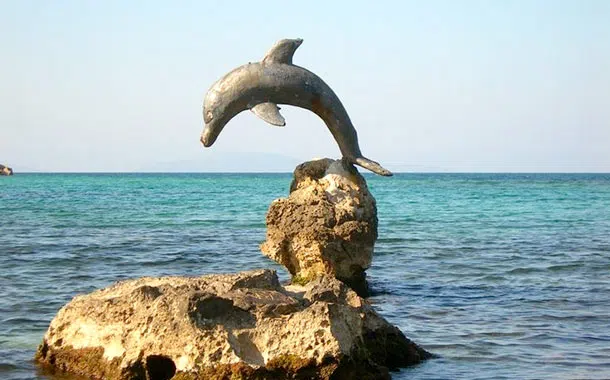
Porto Torres
Porto Torres is an important port in Sardinia from which many cruise ships depart. On Taoticket we have many cruises departing from Porto Torres, discover them all and find the lowest prices for an original holiday in the Mediterranean.
Porto Torres, in the province of Sassari, is one of the most populated and tourist centers in Sardinia. Located in the plain of Nurra, it includes in its territory the Island of Asinara and the Island of Piana. Two rivers mark its boundaries: the Fiume Santo and the Riu Mannu. Porto Torres has very ancient origins, as evidenced by the Neolithic remains present on the territory, visible above all in the Necropolis of Su Crucifissu Mannu.
In recent years, tourism has experienced a considerable growth, especially thanks to the increase in Cruise ships that call or depart from the port of Porto Torres. We recommend the excursion to the Asinara national park, where you can admire magnificent landscapes and immerse yourself in Sardinian and Turritan culture. If you are passionate about Spas, the Terme Centrali, also known as the Palazzo di Re Barbaro, is a must-see archaeological site that will take you on a dip in ancient Rome.
The Terme Maetzke are also very important. If you walk through the city, get lost as far as the small church of San Gavino a Mare, also called "Balai Vicino" or go to the Church of Santu Ischabizzadu, called "Balai lontano".
The Turritan cuisine is naturally rich in fresh fish, try the anchovies in tomato sauce or the freshly caught octopus salad! These dishes are often accompanied by vegetables, such as stewed courgettes, aubergines and fresh broad beans when in season. Characteristic of the region is the traditional use of snails in the kitchen, which are even imported from Tunisia due to the high demand.
Discover the Mediterranean with a cruise from Porto Torres full of emotions and adventures.
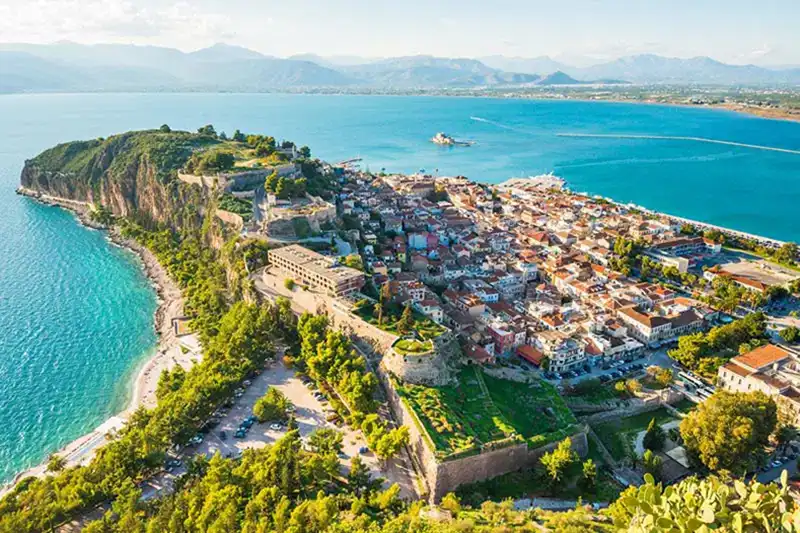
Nafplion
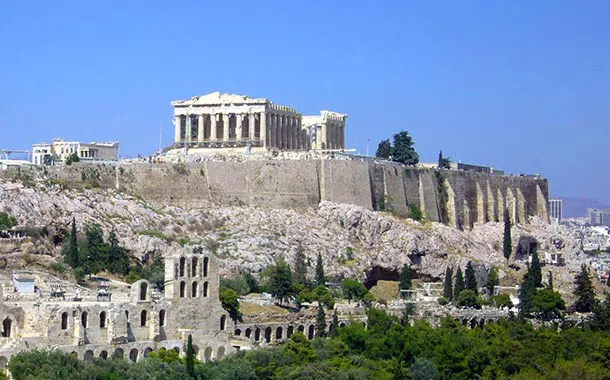
Athens
For many, Athens is a city lived two thousand five hundred years ago. Symbol is the mighty Acropolis which dominates almost every view and itinerary of every visitor, crowned by the iconic Parthenon, stands above the city, watching the sprawling modern metropolis in evolution.
Athens, the capital of Greece, is a city where antiquity and modernity, history and contemporary culture blend in a unique way. Everyone knows that the name of the city derives from the ancient Greek goddess of wisdom and justice. However, few people actually know the legend behind this event. According to myth, Athena and Poseidon, the God of the seas, vied for the right to name the city. Poseidon, to impress the inhabitants, gave them water, while Athena gave them an olive branch.
At first the choice fell on Poseidon, since the citizens considered water the most precious gift. When, once they tasted the water, they discovered that it was salty and not drinkable, they changed their minds and recognized Athena as their patron. One of the most famous historical sites in the city is the Acropolis, a majestic hill topped by ancient Doric temples, including the Parthenon, built in 477 BC. and the Erechtheion, built between 421 and 406 BC. Climbing the Acropolis, tourists can enjoy a breathtaking view of the city and the Aegean Sea. However, Athens is not only history, but also a lively cultural capital. In the Plaka district, located at the foot of the Acropolis, it is possible to stroll through the welcoming streets, visit the traditional Greek taverns and enjoy the authentic atmosphere.
Then there are the numerous cultural activities offered by the numerous museums, galleries and theaters present in the city. Athens is an important port for cruise ships that offer trips to the Mediterranean and beyond. Cruises from Athens allow guests to explore the rich cultural heritage of Greece, including the islands of Crete, Santorini and Mykonos, where you can admire the crystal clear waters of the Aegean Sea and a coast of white houses.
In addition to the Greek islands, cruises from Athens also offer the opportunity to visit other exciting Mediterranean destinations, including historic cities in Italy, Croatia and Turkey. Athens is therefore not only the historical and cultural center of Greece, but also an important starting point for cruises in the Mediterranean, which offers guests the opportunity to immerse themselves in the great history and splendid landscapes of this unique region.
Many still think of Athens as an ancient city that thrived two and a half thousand years ago. Its symbol is the mighty Acropolis, which dominates almost every view and the itinerary of every visitor, and it is crowned by the iconic Parthenon, which rises above the city, overlooking the sprawling and evolving modern metropolis.
Perhaps the most significant change is in the historical centre, which is almost unrecognisable since cars have been banned. This has liberated the area with the most significant archaeological sites, creating the longest, and undoubtedly one of the most splendid, pedestrianised zones in Europe. This huge archaeological park has brought past and present together, returning the cultural and social life of the city to the area around the ancient monuments and surrounding neighbourhoods.
Athens remains a city of contradictions; it is both frustrating and seductive. It is the oldest city in Europe, yet still in a state of transition. It is one of the safest and most vibrant European cities - an intoxicating mix of grunge and grace with an undeniably urban soul.
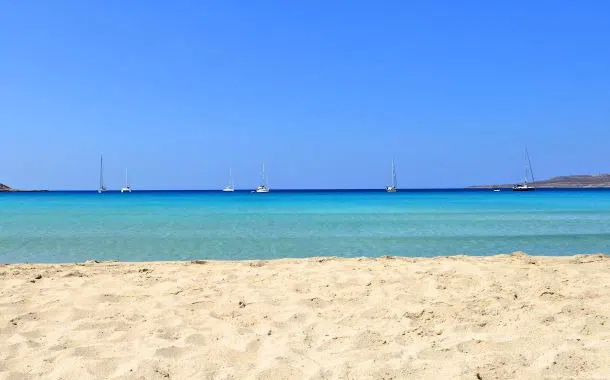
Monemvasia
Monemvasia (Μονεμβάσια) is located in the Peloponnese in the southeast in the prefecture of Laconia, 400 meters from land. Its name derives from two Greek words, mone and emvassi, which means "single entry". It was called Malmsey by old English writers, Malvasia by the Venetians, and Malvoisie by the French.
It was founded by the Byzantines in the 6th century and soon became an important port. It remained in Byzantine possession for almost 700 years until it was captured by the Franks in 1249 after a three-year siege. However, it returned to Byzantine hands ten years later and became the main port of the Despotato of Mystra.
Monemvasia was entirely excavated in the back of a rock in the sea in the Middle Ages. This huge rock was not visible from the mainland, so as to avoid enemy attacks. The only way to reach Monemvasia was by boat, while later a paved path was built to connect the entrance to the castle to the mainland. The Castle of Monemvasia is among the most striking places in Greece. A new city has been built on the mainland, in front of the rock. The walk around the Castle is a journey into the past and the view of the sea from the top of the castle is spectacular.
Inside the village, there is the "Limani" sandy beach, a quiet corner highly recommended for families with small children. On the outskirts of the village, the small bay of "Kavos" with the warmest waters. 20 meters from the town square and behind the beach of Limani, there is the one of "Viandini" with a wild charm and the depth of the water truly very particular. The sea of "Tigania" perfectly wonderful, "blue flag" granted thanks to its proven reputation.
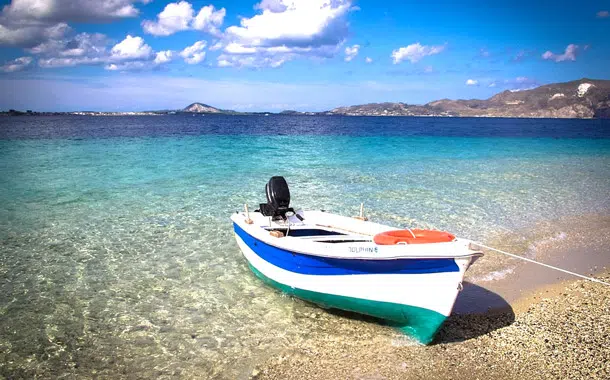
Aghios Nikolaos
Aghios Nikolaos, with over forty years of experience in the tourism sector, is an international and cosmopolitan resort that welcomes thousands of visitors every year.
The lake is its most fascinating feature; connected to the sea by a straight canal, while the natural environment of red rock and trees magnetically attracts the visitor. At a small open-air theater on the lake, residents and tourists can enjoy interesting artistic and cultural presentations. A walk through the shops of Aghios Nikolaos is a pleasant experience. In many shops the visitor can find a wide selection of traditional Cretan works of art, copies of pieces from various archaeological museums, jewelry and embroidery.
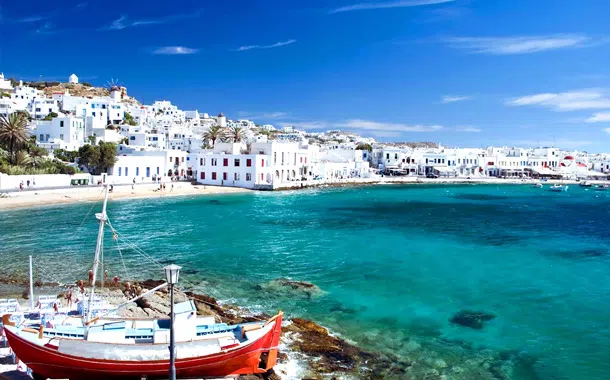
Mykonos
Mykonos is an extremely fun and fascinating place, where the frenetic mix of vacationers, fashionistas and celebrities is magically subdued to the cubist charm of the old town.
Mykonos is famous for being a cosmopolitan destination among the Greek islands and widely recognized as one of the meccas of great tourism. It is one of the most touristy islands in the Aegean Sea. Mykonos tends to be extremely crowded with visitors in July and August. The best time to visit Mykonos is mid-May through June (early in the season, accommodation is much cheaper and it's not that hot), or from September to mid-October.
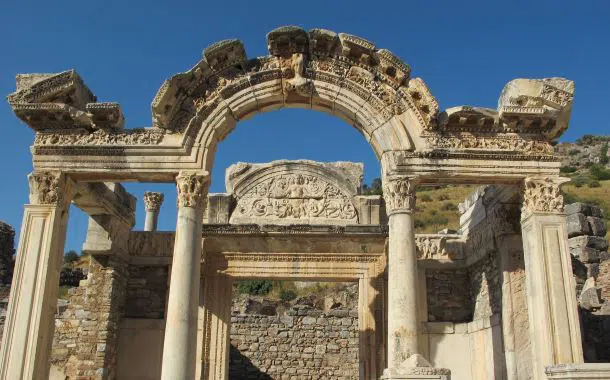
Cesme
Cesme is a renowned resort and spa located 80 kilometers west of the city of Izmir on the western tip of the peninsula.
The most precious city of Izmir. Cesme is located at the very western end of the Urla peninsula and surrounded by the Aegean Sea on three sides.
The country is located opposite Chios at the western end of Turkey. The literal meaning of Cesme in Persian is "fountain", it owes its name to the various Ottoman fountains that dot the city.
It boasts a fabulous natural landscape with unique locations for scuba diving lovers. The most popular diving spots are Fener Island, Yatak Island, Esek Island, and Ildiri Bay. The golden beaches, shallow and fine sand ideal for children. The warm sea, the elegant and welcoming atmosphere.
With a lively nightlife, which starts until the early hours of the morning with beach parties, discos, entertainment shows, and concerts by famous singers, are just some of the entertainment activities offered in this holiday paradise.
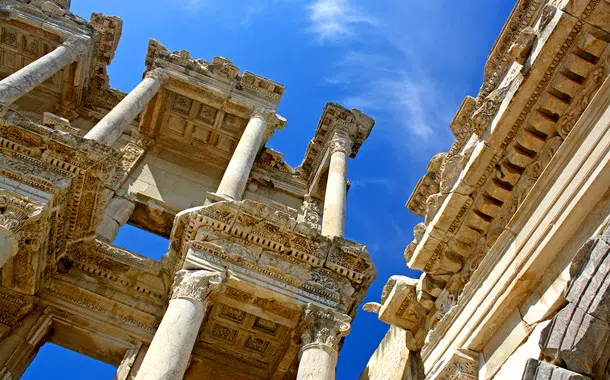
Kusadasi
Kusadasi is one of the main tourist centers of Turkey and offers an excellent environment for an unforgettable holiday.
Located on the west coast of Turkey, 90km south of Izmir, Kusadasi, is reputed to be one of the most beautiful cities in the Aegean Sea, as it is close to important historical sites including Ephesus, Didima, Priene, Miletus and is ideal for tourists. Numerous beaches of fine sand with warm and clear waters, offer a peaceful atmosphere, allow a great variety of services in the water and on the beach. Windsurfing, water skiing, sailing, and beach volleyball are just some of the choices for lovers of dynamism. After the sun during the day, the city awaits superb sunsets. As the sun sets, the attractive cafes and restaurants across the palm-lined avenues fill with sounds and voices. It is a great pleasure to watch the comings and goings of boats and ships accompanied by the panoramic view of the sunset.
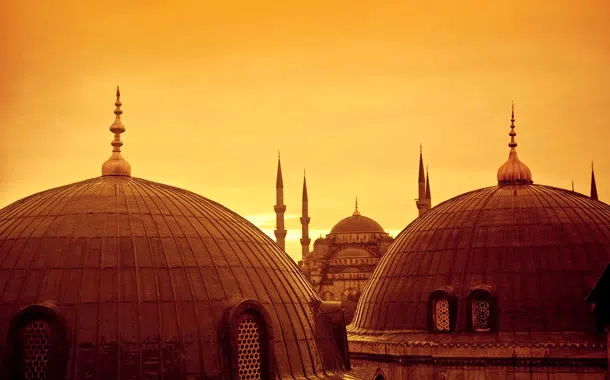
Istanbul
An incredible city, huge, vibrant like few others in the world. Where two continents meet, culture and diversity thrive in a unique architectural setting. Istanbul is hot,and we aren’t talking about the weather. These days there are more restaurants,bars,galleries and clubs around the city than Ottoman mosques(which is not a small feat).
The international fashion and design press has talked about Istanbul to the point of exhaustion; the sense of age that fell over the city once the Ottoman empire disappeared, has been replaced by a sense of energy and innovation not seen since the times of Suleiman the Magnificent.
